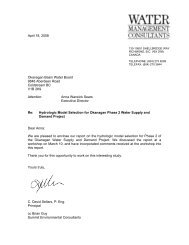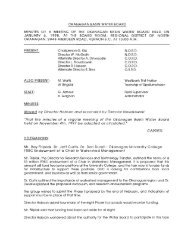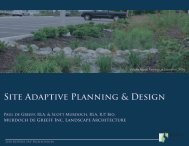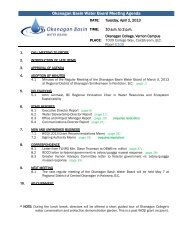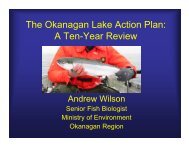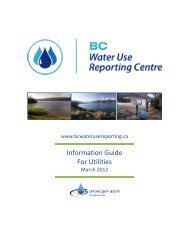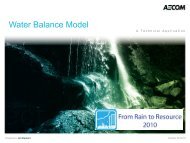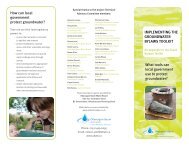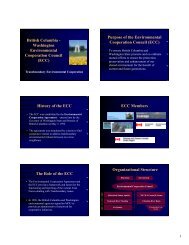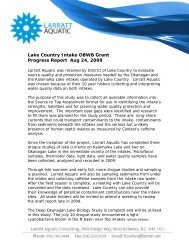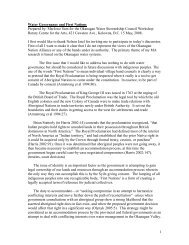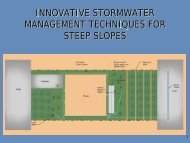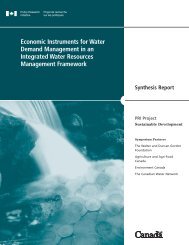FINAL<strong>Okanagan</strong> <strong>Basin</strong> <strong>Instream</strong> <strong>Flow</strong> <strong>Needs</strong>Design for the futureThe initial implementation of any IFN method will be constrained by currently available data. Methodsshould not be assumed to be static, but should be expected to be refined and improved over time as betterinformation becomes available, particularly with respect to data poor watercourses. The most powerfulmethod for determining required instream flows is through well-designed adaptive managementapproaches that take advantage of natural or anthropogenic variations in flows, and monitor the responseof local biota (e.g., distribution and abundance of resident fish populations) to these flow variations.While it is clearly not feasible to do this at all fish bearing nodes, it may be possible to classify streamnodes into a set of strata based on their attributes (e.g., perceived sensitivity, level of confinement, percentof groundwater contributions to flow, etc.) and then select one or two streams to monitor in the futurefrom each of these strata.2.2 Natural flow regimeA growing body of literature treats flow as the “master” variable regulating the form and function ofriverine habitats through changes in parameters such as the frequency, magnitude, timing, duration, andrate of change of flow. Dam and water diversion related alterations of river flow regimes have beenidentified as one of three leading causes of declines in imperiled aquatic ecosystems (the others beingnonpoint source pollution and invasive species; Richter et al. 1997, Pringle et al. 2000). Many riverdependentplants and animals are influenced by natural variations in river flow—so much so that theyoften possess traits that allow them to tolerate or exploit specific seasonal flow conditions. An emergingbody of literature supports the notion that there are strong interconnections between flow regime and thespecies that have adapted to live within the riparian and aquatic environments. This has led to anevolution in ecological thinking away from minimum flow standards. Instead, streamflow as mastervariable is now widely accepted as the driver of many critical physiochemical characteristics of rivers,such as water temperature, channel geomorphology, and habitat diversity that limits the distribution andabundance of riverine species and regulates the ecological integrity of flowing water systems (Poff et al.1997). This concept, also referred to as the “natural flow regime”, has been investigated and summarizedby Poff and Ward (1990), Ligon et al. (1995), Collier et al. (1996), Stanford et al. (1996), Poff et al.(1997), Friedman et al. (1998), Rood et al. (1998), Mahoney and Rood (1998), Richter and Richter(2000), Richter et al. (2003), Dilts et al. (2005), TNC et al. (2008). Ultimately, the body of knowledgesurrounding the pattern of changes in flow quantity, timing and variability now advocates a shifttowards a dynamic, state-dependent approach to the quantification of ecological flow needs oversimplistic “rules of thumb” and static minimum flows.Traditionally, approaches used for estimating environmental flow requirements for streams have oftenfocused on the narrow intent of establishing minimum allowable flows for certain fish species (Poff et al.1997). These approaches generally come with a primary aim of generating administrative simplicity andcertainty: “tell me the minimum flows needed so that I know how much water I can dam and divert tomeet human needs.” But modern understanding of ecology (references in previous paragraph) clearlyindicates that fish and other aquatic organisms require habitat features that cannot be maintained byminimum flows alone. For example, a range of flows are required to scour and revitalize gravel beds, torecruit and transport wood and organic matter, to provide periodic access to fringing wetlands, and tomaintain other important features of channel and riparian dynamics. As shown by the <strong>Okanagan</strong>Fish/<strong>Water</strong> Management Tool (Alexander et al. 2008) and the Sacramento River Ecological <strong>Flow</strong>s Tool(TNC et al. 2008), all of these ideas can be formed into a custom package of dynamic, state-dependentflow rules and guidelines for specific systems and focal species.Lastly, it is important not to confuse natural flow regime theory with the idea of reverting all aquaticriparian systems back to their “historic pre-settlement conditions”. Rather, re-establishing at least someESSA Technologies Ltd. & 10Solander Ecological Research
FINAL<strong>Okanagan</strong> <strong>Basin</strong> <strong>Instream</strong> <strong>Flow</strong> <strong>Needs</strong>level of this natural flow regime should provide significant ecological benefits and can serve as a usefulinitial management and restoration goal. Recognizing the natural variability of river flow and explicitlyincorporating the five components of the natural flow regime (i.e., magnitude, frequency, duration,timing, and rate of change) into the broader management framework of <strong>Okanagan</strong> <strong>Basin</strong> water needswould constitute a major management advance over the traditional focus on minimum flows and just afew fish species.2.3 Hierarchy of methodsOur recommended approach for determining recommended IFN flows at fish-bearing <strong>Okanagan</strong> nodes isa combination of two IFN methodologies for guideline setting that are accepted in the scientific literatureand supported by BC government biologists. The two methods we recommend are also currently beingused in tandem for developing instream flow needs for fish within the Nicola <strong>Water</strong> Use ManagementPlan (Hatfield 2009). Site-specific studies in the <strong>Okanagan</strong> which currently inform flow guidelines willsupplement or supersede our general IFN recommendations in <strong>Okanagan</strong> River, Trout Creek, and MissionCreek. The overall methodological framework we have adopted for IFN recommendations is presented inFigure 2.1.11 ESSA Technologies Ltd. &Solander Ecological Research



